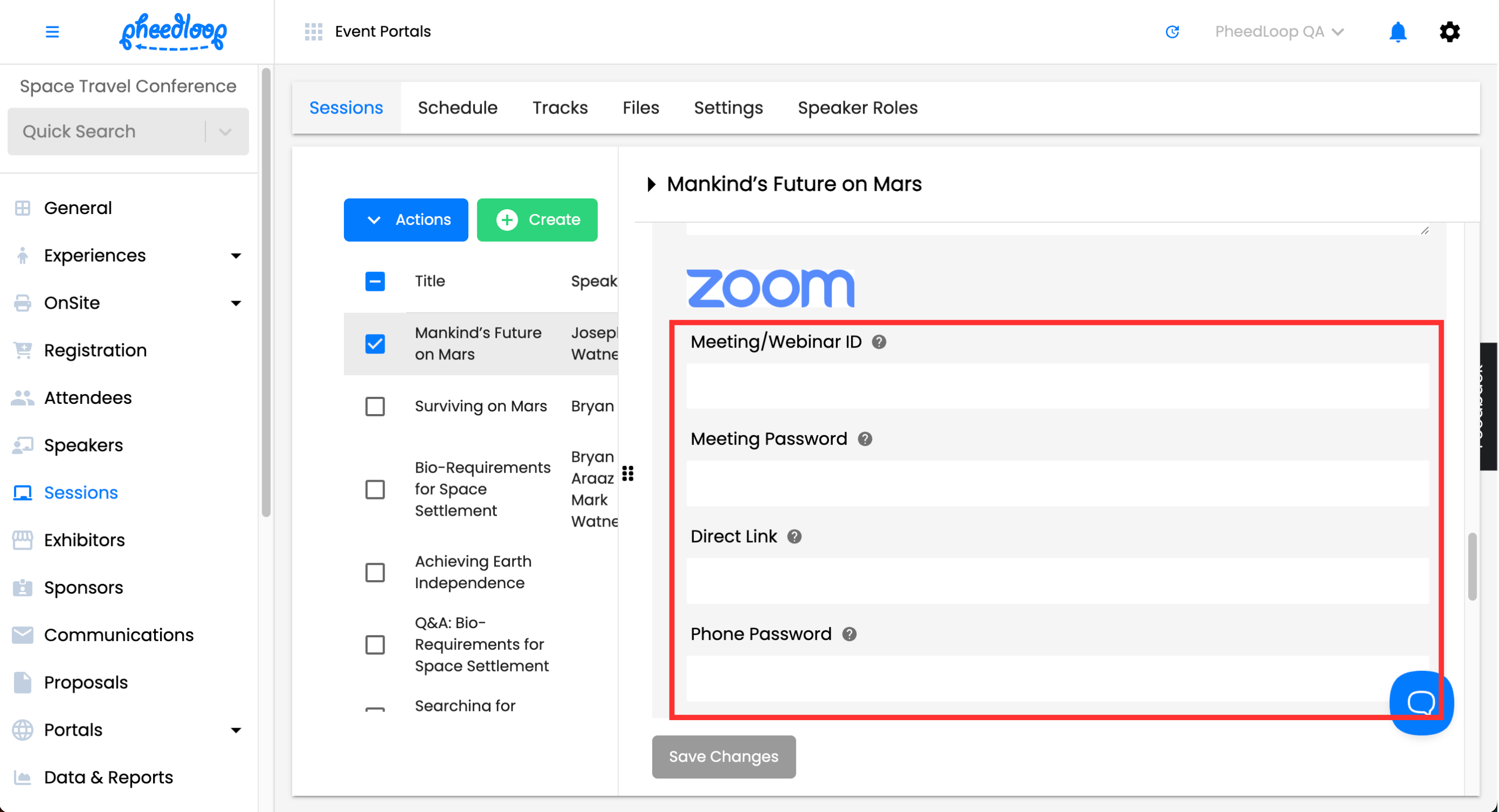Setting Up Zoom Meetings & Webinars for Session Streaming
Note: If you are looking for PheedLoop's built-in Meet & Stream solution, learn more about that here.
Zoom is a powerful and popular tool used by event planners to host virtual sessions. PheedLoop supports fully functional integration with Zoom which allows you and attendees to view and participate in Zoom meetings and webinars right from the Virtual Event Portal. PheedLoop's integration allows attendees to automatically authenticate and join the Zoom meeting or webinar you are running. The Zoom interface even matches your event's color theme, so everything feels seamless!
Step 1 - Create a Zoom Meeting or Webinar
The first step is to create your meetings or webinars to serve as your sessions for PheedLoop. Depending on the type of session(s) you are going to be running, you'll want to choose a Zoom Meeting or Webinar. At a high level, a Zoom Meeting is ideal for a collaborative session where all attendees can contribute to a larger discussion with their audio/video. In contrast, a Zoom Webinar is ideal for a lecture-style session where attendees are primarily listening to one or more speakers delivering a talk/panel.
For a complete overview of the differences between meetings and webinars, visit this link. To learn how to schedule a Zoom meeting, visit this link and to learn how to schedule a Zoom webinar, visit this link.
Ideally, all of your Zoom Meetings or Webinars are recorded in case you'd like to upload these videos back into PheedLoop to make the sessions available on-demand. You can ensure recording is enabled in your Zoom settings. If you plan on having concurrent sessions for your event, note that you will need multiple host licenses from Zoom as a single host can only host one Zoom session at a time.
For more information on setting up recordings for Zoom, visit this link.
Please note, if you are running a Zoom Webinar, please ensure that registration for your webinar is turned off as webinars requiring registration do not work with the Zoom integration.
Step 2 - Populate Your Session in PheedLoop with the Zoom Meeting/Webinar Details
Now that you have created your Zoom Meeting, you can now add the meeting details to your session in the Event Dashboard. If configured correctly, the Zoom meeting will now be embedded into the session for the Virtual Portal and PheedLoop Go!.
- From the Event Dashboard, navigate to Sessions > Sessions and select the session you wish to adjust
- Scroll down to Virtual Settings
- Toggle on the Enable Stream checkbox if you are ready to start your stream
- Under the Meeting/Webinar ID field, enter the Meeting/Webinar ID for your Zoom meeting
- Under the Meeting Password field, enter the password for your Zoom meeting
- If entered, Attendees will be able to access the meeting without needing to enter the password. If this field is blank then Attendees will need to enter the password before accessing the Zoom meeting.
- Under the Direct Link field, enter the meeting URL if you would like to direct attendees to the Zoom app or browser
- Under the Phone Password field, enter the password for Attendees connecting in their phones
- If entered, Attendees will be able to access the meeting without needing to enter the password when joining with their phone. If this field is blank then Attendees will need to enter the password before accessing the Zoom meeting.
Select Save Changes

For more information on session streams, please review our How to Enable Streams for Virtual Sessions article.
We recommend toggling on Enable Stream temporarily for the session to ensure it works. For a live event, you'll want to enable the stream at the time when your session starts. More information about enabling streams is available here.
Step 3 - Test the Integration
You've finally made it, the last step! Start the Zoom Meeting or Webinar you created in the native Zoom app (we typically recommend moderators and speakers use the native Zoom app to start and join the meeting or webinar) and ensure you're out of practice mode if you're running a Zoom Webinar (i.e. the webinar or meeting should be live and running).
- From the Virtual Portal, navigate to Sessions
- Select the Session you wish to test
The session should now display the Zoom meeting.
We recommend all speakers to join the session directly via the Zoom Desktop App for the best quality experience.
Please note we do not recommend using Zoom's spotlight feature for more than four individuals. This is to ensure that your presenters are displayed correctly in the PheedLoop.

Like with any other technology, when first getting it going there may be some troubleshooting required. In the Zoom integration's case, they are typically caused by very basic issues such as getting the meeting/webinar ID or password wrong, or simply not starting the correct Zoom session. We've listed a few common troubleshooting and frequently asked questions here.
Frequently Asked Questions
Where do speakers login to conduct their speaking engagement when using the Zoom integration?
Speakers are always recommended to login to the Zoom desktop app to conduct their speaking engagement. We do not recommend logging into PheedLoop to avoid any echos. Additionally, by logging into Zoom directly, you will be able to get the best streaming quality and will be able to leverage some of Zoom's advanced features such as Live Polling and Q&A.
What advanced features are supported within the Zoom integration?
Zoom is constantly updating their integration with PheedLoop. Some of the features that are currently supported within the integration are: Breakout Rooms, Live Polls, Q&A and Interpretations. As the event admin or speaker, you must initiate these features from the native Zoom desktop app.
